|
Artists have used pastels and created works on
paper since the Renaissance, but when we think of the medium, we generally
visualize Renoirs or gentle landscapes and still lifes of 19th century
vintage.
A new exhibit at the Bowdoin College Museum, Powdered Pigments,
succinctly illustrates that not only do pastels as a medium have a far
greater technical range but they have a wide expressive one as well.
The small, but well-chosen, display of thirty works gives an appealing
sense of the use of the medium over time from the 18th-20th centuries.
As a medium, pastels consist of
powdered pigment held together by a neutral-colored binder of low
saturation. The hues are closer to the natural dry pigments than in
oils or other media. Often, pastels are used in combination with other
media such as watercolor, ink, or gouache (opaque pigments ground in water
and bound with a glue-like substance) to amplify or diversify the effect.
The exhibit explores the many visual combinations and possibilities of
using powdered pigment. The viewer discovers that while softness may
characterize some of the most beloved works, boldness and even brash
abstraction thrive in pastel as well.
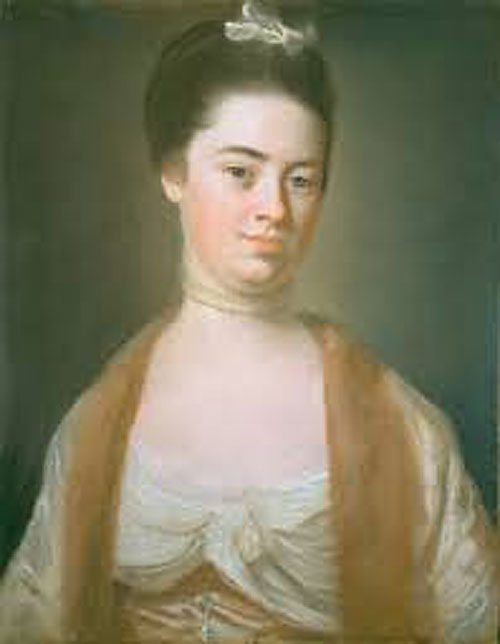
Beginning with several striking 18th century portraits, we see the subtleties
possible in layering the pastels on paper for a supremely realistic look.
John Singleton Copely Portrait of Elisabeth Bowdoin is one of a collection
of some fifty-five pastels drawings the artist made for prominent New
World families. The overall feeling is warmer and more animated than that
of the artist's oils, which have a somewhat hard-edged quality to them. The
draughtsmanship and skill at rendering the sitter are the same, but the skin
breathes with a gently brushed texture and the atmosphere around the
sitter has a dynamic feel to it. Similarly alive is Deschamps de la Talave's
1767 Portrait of a Bi-Racial Woman which depicts a beautiful young
woman whose lips turn up ever so slightly in a Mona Lisa smile with warm
brown skin in an exotic headdress. The artist's skill is evident in suggesting
the fabric of her dress with its gossamer touches.
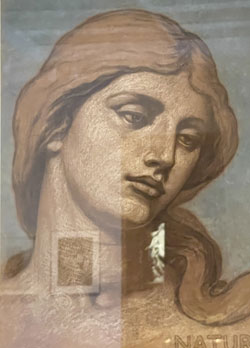 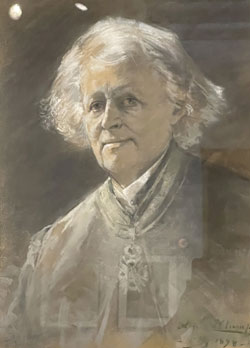
The 19th century is also represented by pastel portraiture. Notable among
these is Elihu Vedder's 1893 Pre-Raphaleite Head of a Woman with its
strong sculptural feeling and subtle neutral hues delineated by economic
linear outlines. In this, as in many of the works on paper, the paper itself
plays a major supporting role to the pigment, using the cream tones of the
page as underpinnings for the flesh. Another riveting portrait is Anne
Elizabeth Klumpke's 1898 portrait of the painter Rosa Bonheur. This is a
far less stylized work than the Vedder. Bonheur is depicted as an elegant,
somewhat masculine-looking, elderly woman with wispy white hair,
wearing a medal of honor around her neck. Her eyes are soft blue and
incredibly engaging, and her smile is serene. The entire image is done in
neutral shades of grays and beiges, and the artist's use of light is exquisite.
Bonheur is lit from the left side and her hair shimmers in the glow, her
features gently limned. But there is also a sense of inner light from her
face and eyes that makes the sitter come alive and leap off the page.
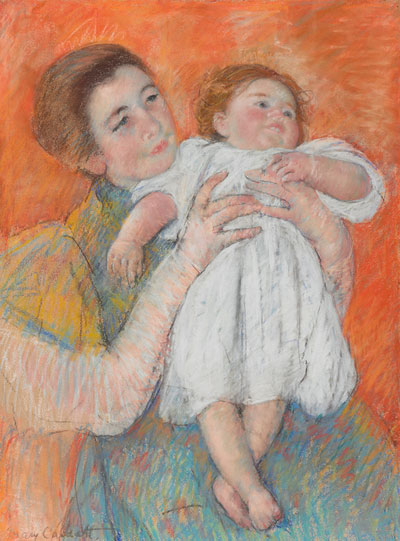
Among the other 19th century works are two pastels in the Impressionist
mode by Americans: Mary Cassatt's Barefoot Child and John Appleton
Brown's Old-Fashioned Garden. Like so many of Cassatt's other works, the
artist presents the viewer with an intimate look at her subjects. An auburn
-headed, rosy-cheeked young mother bounces a plump baby on her lap.
The mother smiles with pride, while the baby is the picture of health and
contentment. Cassatt's handling of the pastels is bolder than the earlier
artists, and her palette is brighter- orange background, teal and yellow
dress for the mother contrasted with the white of the baby's garment. The
flesh of both is infused with warm pinks, corals, and dashes of white.
Cassatt's pastel strokes are cross-hatched, especially for the clothing and
background with only the faces smoothed into subtlety. The figures are
outlined slightly to give a strong linear feel to the piece and the overall
sensation projected is energetic and lively.
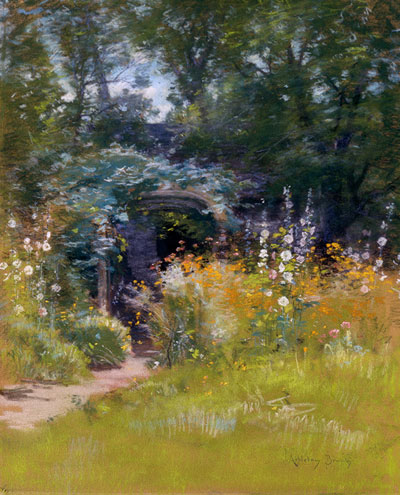
Appleton's Old Fashioned Garden is a much more serene work showing a path through a wooded area dotted with wildflowers. There is a softness
and blending of tones in a palette that uses the pinks, whites, and yellows
of the blossoms as occasional punctuation in the sea of soft and varied
greens. Clearly, Monet, Renoir, Pissaro and company are the inspirations
here.
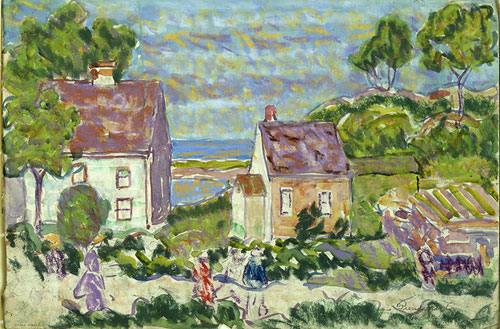
In vivid contrast to these delightful, yet highly conventional late
19thcentury works, there is Maurice Prendergast's Maine Coastal Village,
a gouache and pastel drawing from 1916, which uses the opacity of the
gouache very much like oil or tempera. Prendergast's depiction of two
cottages in their beach gardens perched above a blue Maine sea makes use
of the energetic brushwork for which the artist is known. In the Post
-Impressionist tradition, Prendergast combines geometric form with
dancing linear motion and bright color influenced by the Fauves. The
Bowdoin work is beautifully displayed in a double glass frame that allows
the viewer to appreciate the opacity of the artist's pigments.
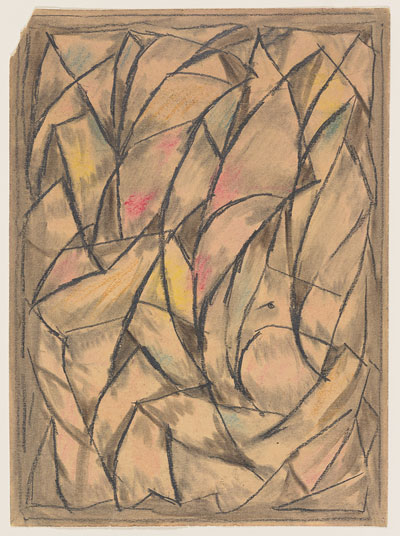
Three other works demonstrate the versatility of the pastel medium as
artists move into 20th century abstraction. Untitled by Abraham
Walkowitz (1916) is a Cubist inspired study in pure abstract form. Using
pastel and charcoal with watercolor to smooth the textures, this
composition in beige neutrals is a study in movement and momentum with
each of the three media assigned a different rhythmic role.
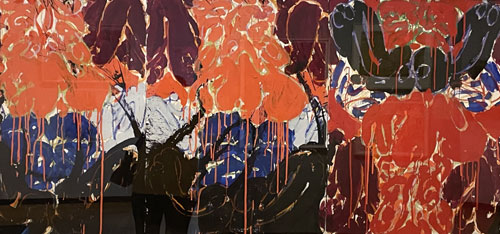
Norman Bluhm's 1984 Tryptych #6 is as brash as Untitled is quiet. Red,
cobalt blue, and viridian green forms suggest tropical foliage from which
emerge a mask-like face and a series of shadowy other forms that might
suggest an eagle head and elephants. The pastels are applied with a wild,
dancing abandon, and, as with the Post Expressionists, the emphasis is on
color and jolting energy.
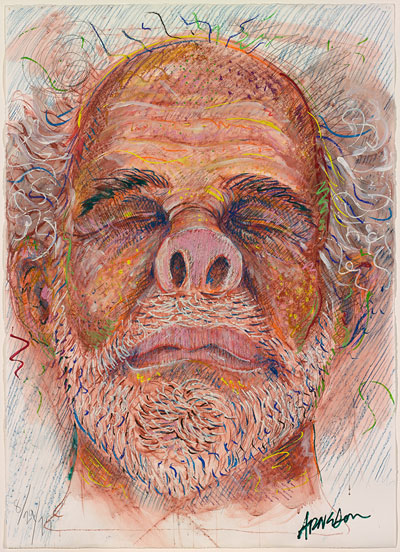
The final striking image is once again a 1979 self-portrait by San Francisco
artist Robert Carston Arneson entitled Up Against It. Using pastel,
watercolor and graphite, Arneson allows the head to fill the page. Wild,
wiry gray hair and beard frame a strong-featured face with full lips and
prominent nose. The subject's eyes are closed and his wide-flared nostrils
suggests he may be breathing in or exhaling deeply. There is a sense of his
being in a separate space, on another plane at the same time that there is
an unapologetic openness about the presentation of self. The title suggests
inner and outer conflict but the subject resonates strength and endurance.
If we compare this last portrait in the collection to the formal ones with
which this mini-exhibit begins, and we comprehend the expressive range of
the pastel medium as well as its technical adaptability to the changing
styles throughout art history. If there is an added appeal, it is the feeling of
immediacy that these pigments, applied so quickly and directly to the
paper, have for the viewer. Traditionally working in powdered pigments
suggests a quicker execution - but also one which permits fewer revisions
. And thus, there is a sense of spontaneity about these thirty works that
makes them leap off the page, defying time and belying technique, and
establishing their credibility in an art world often dominated by oil
painting.
|